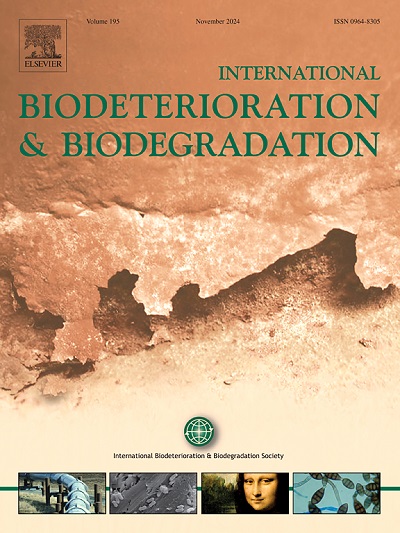Streamlining automation in a rapid wood durability test against the marine wood boring crustacean, Limnoria quadripunctata.
IF 4.1
2区 环境科学与生态学
Q2 BIOTECHNOLOGY & APPLIED MICROBIOLOGY
International Biodeterioration & Biodegradation
Pub Date : 2025-02-01
DOI:10.1016/j.ibiod.2024.105993
引用次数: 0
Abstract
Gribble significantly impact the biodegradation of wood in marine environments, causing costly damages, but can be used to easily assess wood consumption rates. Faecal pellet production indicates feeding rate and is a good proxy for degradation. However, counting large numbers of pellets by eye may be impractical with multiple replicates. Optimising a rapid, cost-effective, and user-friendly protocol to evaluate wood durability against gribble can be used in development of sustainable wood protection methods. Automated counting methods ImageJ and FlowCAM, were evaluated against manual counts for efficiency and accuracy. ImageJ was more suitable for large sample volumes, offering a balance of cost, time, and accuracy. Both methods showed greater degrees of error as faecal pellet counts increased. ImageJ tended to undercount, whereas FlowCAM often overcounted significantly. The FlowCAM rapidly processed individual samples, however loading/unloading samples increased time-consumption as replicates increased. ImageJ was able to process multiple samples at once so total time was not influenced by sample size. This research underlines the importance of optimising counting methods to accurately assess the impact of gribble on wood degradation, offering a streamlined approach for both specialist and non-specialist laboratories to evaluate wood durability and enhance the development of non-toxic, sustainable wood protection solutions.
简化自动化快速木材耐久性测试对海洋木材钻孔甲壳动物,Limnoria quadripunctata。
Gribble显著影响海洋环境中木材的生物降解,造成昂贵的损害,但可以很容易地用来评估木材消耗率。粪便颗粒产量反映了摄食率,是降解的良好指标。然而,在多次重复的情况下,肉眼计数大量颗粒可能是不切实际的。优化一个快速,具有成本效益和用户友好的协议来评估木材的耐久性,以防止gribble可用于可持续木材保护方法的发展。自动计数方法ImageJ和FlowCAM与人工计数的效率和准确性进行了评估。ImageJ更适合大样本量,提供了成本、时间和准确性的平衡。随着粪便颗粒计数的增加,这两种方法都显示出较大程度的误差。ImageJ倾向于少计数,而FlowCAM经常明显多计数。FlowCAM可以快速处理单个样品,但是随着重复次数的增加,加载/卸载样品的时间会增加。ImageJ能够一次处理多个样本,因此总时间不受样本大小的影响。这项研究强调了优化计数方法的重要性,以准确评估木屑对木材降解的影响,为专家和非专业实验室提供了一种简化的方法来评估木材的耐久性,并加强了无毒、可持续木材保护解决方案的开发。
本文章由计算机程序翻译,如有差异,请以英文原文为准。
求助全文
约1分钟内获得全文
求助全文
来源期刊
CiteScore
9.60
自引率
10.40%
发文量
107
审稿时长
21 days
期刊介绍:
International Biodeterioration and Biodegradation publishes original research papers and reviews on the biological causes of deterioration or degradation.

 求助内容:
求助内容: 应助结果提醒方式:
应助结果提醒方式:


